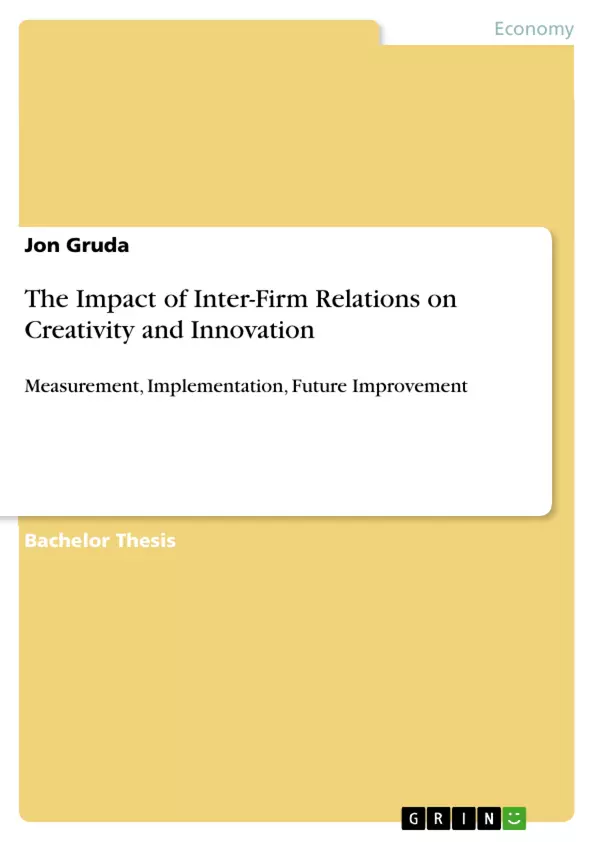
The Impact of Inter-Firm Relations on Creativity and Innovation
Bachelorarbeit, 2010
23 Seiten, Note: A
Leseprobe
Inhaltsverzeichnis (Table of Contents)
- 1 Introduction
- 2 Methodology
- 3 Research Variables
- 3.1 Inter-Firm Relations
- 3.2 Creativity and Innovation
- 4 Literature Review
- 5 Overview of Discussion
- 5.1 Creativity, Innovation and Implementation
- 5.2 Learning Organization Perspective
- 5.3 Product Innovation in Emerging International Joint Ventures
- 5.4 Innovation Intensity of Firms and Inter-Firm Cooperation
- 5.5 Inter-Firm Relations benefitting IT innovation
- 6 Discussion
- 6.1 Firm Size
- 6.2 Historical Tracking
- 7 Conclusion
- 8 Limitations and Future Research
Zielsetzung und Themenschwerpunkte (Objectives and Key Themes)
This study aims to provide a comprehensive understanding of how the characteristics of inter-firm relations influence creativity and innovation. It analyzes existing literature to build a flexible theoretical framework for assessing this relationship, considering various factors and their impact on innovation implementation processes.
- The impact of inter-firm relations on creativity and innovation.
- The role of various factors (firm size, historical context, trust, etc.) in influencing innovation.
- The development and implementation of creative ideas leading to innovation.
- Contrasting perspectives and findings from different research studies on innovation.
- A framework for understanding and analyzing innovation within different firm contexts.
Zusammenfassung der Kapitel (Chapter Summaries)
1 Introduction: This introductory chapter establishes the crucial role of innovation in driving human advancement and business success. It highlights the prevalence of inter-firm relations in shaping innovation, emphasizing the study's focus on analyzing how the characteristics of these relations influence creativity and innovation. The chapter briefly mentions existing literature on the topic but states that the present study seeks a more integrative and universal approach to understanding this complex relationship, avoiding a focus on trust, a variable previously thoroughly investigated. The study's objective is to analyze how inter-firm relation characteristics influence creativity and innovation by contextualizing factors from previous literature and examining their effects on innovation and implementation.
2 Methodology: This chapter outlines the research methodology, emphasizing the reliance on secondary sources, primarily academic articles, to examine the concepts of inter-firm relations and innovation. The study employs a literature review to examine five key articles, which serve as the foundation for analyzing firm size and the historical tracking of innovation. Conclusions and limitations are presented at the paper's end, followed by an outlook for future research.
3 Research Variables: This section introduces the theoretical models and data for the two main research variables: inter-firm relations and innovation. It defines and categorizes different types of inter-firm relations (strategic alliances, joint ventures, etc.) based on Lasserre (2007) and classifies the process of creativity and innovation into four key stages (opportunity recognition, idea generation, invention, and commercialization) according to Pretorius and Millard (2005). The section aims to clarify and theoretically focus the thesis, including explanations of the applied theories.
4 Literature Review: This chapter reviews existing literature on innovation, emphasizing its role as the dependent variable in the study's framework. The review discusses several key articles that analyze various aspects of inter-firm relations and their influence on innovation, highlighting the diversity of theoretical perspectives and methodological approaches used in these studies. The chapter sets the stage for the subsequent discussion by presenting a range of viewpoints on innovation from different researchers and industries.
5 Overview of Discussion: This section provides an overview of the most significant findings and research activities in the field up to the time of writing. It presents five key articles, each detailing various empirically tested variables influencing innovation via inter-firm relations. The chapter details the results and findings of each article, setting up the following discussion chapter.
6 Discussion: This chapter addresses the core research question: How do the characteristics of inter-firm relations influence innovation? It focuses on two main points derived from the literature review: firm size and historical tracking of innovation. The chapter carefully considers contradictions and nuances in existing research, providing a detailed analysis of the relationships between firm size and innovation capacity, and examining the limitations of using historical data to predict future innovation trends. It concludes that there is no single universal solution and that an individualized approach is necessary when considering innovation strategy.
Schlüsselwörter (Keywords)
Inter-firm relations, creativity, innovation, firm size, historical tracking, strategic alliances, joint ventures, R&D, knowledge sharing, firm performance, product innovation, learning organization, industry innovation, competitive advantage.
FAQ: Comprehensive Language Preview - Understanding Inter-firm Relations and Innovation
What is the main objective of this study?
This study aims to comprehensively understand how the characteristics of inter-firm relations influence creativity and innovation. It analyzes existing literature to build a flexible theoretical framework for assessing this relationship, considering various factors and their impact on innovation implementation processes.
What are the key themes explored in this study?
Key themes include the impact of inter-firm relations on creativity and innovation; the role of various factors (firm size, historical context, trust, etc.) in influencing innovation; the development and implementation of creative ideas leading to innovation; contrasting perspectives and findings from different research studies on innovation; and a framework for understanding and analyzing innovation within different firm contexts.
What methodology was used in this study?
The study relies primarily on secondary sources, mainly academic articles, to examine inter-firm relations and innovation. A literature review of five key articles forms the foundation for analyzing firm size and the historical tracking of innovation.
What are the key research variables?
The two main research variables are inter-firm relations (categorized based on Lasserre, 2007) and innovation (classified into four stages according to Pretorius and Millard, 2005).
How does the study define and categorize inter-firm relations?
Inter-firm relations are defined and categorized based on Lasserre (2007), encompassing various types such as strategic alliances and joint ventures.
How does the study define and categorize innovation?
The process of creativity and innovation is classified into four key stages: opportunity recognition, idea generation, invention, and commercialization, according to Pretorius and Millard (2005).
What is the focus of the literature review?
The literature review examines existing research on innovation, focusing on the influence of inter-firm relations. It highlights diverse theoretical perspectives and methodological approaches from various studies.
What are the key findings discussed in the "Overview of Discussion" section?
This section summarizes the key findings and research activities from five significant articles detailing empirically tested variables influencing innovation through inter-firm relations.
What is the main research question addressed in the discussion chapter?
The core research question is: How do the characteristics of inter-firm relations influence innovation?
What are the two main points of focus in the discussion chapter?
The chapter focuses on firm size and the historical tracking of innovation, analyzing their relationships with innovation capacity and the limitations of using historical data for future predictions.
What is the overall conclusion of the study?
The study concludes that there's no single universal solution for innovation strategy, emphasizing the need for an individualized approach.
What are the key limitations and future research directions?
Limitations and potential avenues for future research are presented in the final chapter.
What are the keywords associated with this study?
Keywords include inter-firm relations, creativity, innovation, firm size, historical tracking, strategic alliances, joint ventures, R&D, knowledge sharing, firm performance, product innovation, learning organization, industry innovation, and competitive advantage.
What is covered in the introduction chapter?
The introduction establishes the importance of innovation and highlights the study's focus on analyzing how the characteristics of inter-firm relations influence creativity and innovation. It briefly mentions existing literature and states the study's objective of analyzing how inter-firm relation characteristics influence creativity and innovation.
What is covered in the methodology chapter?
This chapter details the research methodology, emphasizing the use of secondary sources (primarily academic articles) and a literature review of five key articles. It outlines the approach to analyzing firm size and historical innovation tracking.
What is covered in the chapter on research variables?
This section introduces the theoretical models and data for the two main research variables: inter-firm relations and innovation. It defines and categorizes different types of inter-firm relations and classifies the process of creativity and innovation into four key stages.
What is covered in the conclusion chapter?
The conclusion summarizes the findings and reiterates the key insights regarding the relationship between inter-firm relations and innovation.
Details
- Titel
- The Impact of Inter-Firm Relations on Creativity and Innovation
- Untertitel
- Measurement, Implementation, Future Improvement
- Hochschule
- Rijksuniversiteit Groningen (Faculty of Economics and Business)
- Veranstaltung
- International Business & Management
- Note
- A
- Autor
- MSc. Jon Gruda (Autor:in)
- Erscheinungsjahr
- 2010
- Seiten
- 23
- Katalognummer
- V184270
- ISBN (eBook)
- 9783656089964
- ISBN (Buch)
- 9783656090229
- Dateigröße
- 511 KB
- Sprache
- Englisch
- Schlagworte
- impact inter-firm relations creativity innovation measurement implementation future improvement
- Produktsicherheit
- GRIN Publishing GmbH
- Preis (Ebook)
- US$ 17,99
- Preis (Book)
- US$ 20,99
- Arbeit zitieren
- MSc. Jon Gruda (Autor:in), 2010, The Impact of Inter-Firm Relations on Creativity and Innovation, München, Page::Imprint:: GRINVerlagOHG, https://www.diplomarbeiten24.de/document/184270
- Autor werden
- Ihre Optionen
- Vertriebskanäle
- Premium Services
- Autorenprofil
- Textarten und Formate
- Services für Verlage, Hochschulen, Unternehmen

- © GRIN Publishing GmbH.
- Alle Inhalte urheberrechtlich geschützt. Kopieren und verbreiten untersagt.
- info@grin.com
- AGB
- Open Publishing
Der GRIN Verlag hat sich seit 1998 auf die Veröffentlichung akademischer eBooks und Bücher spezialisiert. Der GRIN Verlag steht damit als erstes Unternehmen für User Generated Quality Content. Die Verlagsseiten GRIN.com, Hausarbeiten.de und Diplomarbeiten24 bieten für Hochschullehrer, Absolventen und Studenten die ideale Plattform, wissenschaftliche Texte wie Hausarbeiten, Referate, Bachelorarbeiten, Masterarbeiten, Diplomarbeiten, Dissertationen und wissenschaftliche Aufsätze einem breiten Publikum zu präsentieren.
Kostenfreie Veröffentlichung: Hausarbeit, Bachelorarbeit, Diplomarbeit, Dissertation, Masterarbeit, Interpretation oder Referat jetzt veröffentlichen!
- GRIN Verlag GmbH
-
- Nymphenburger Str. 86
- 80636
- Munich, Deutschland
- +49 89-550559-0
- +49 89-550559-10
- info@grin.com
-









